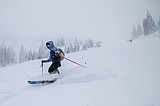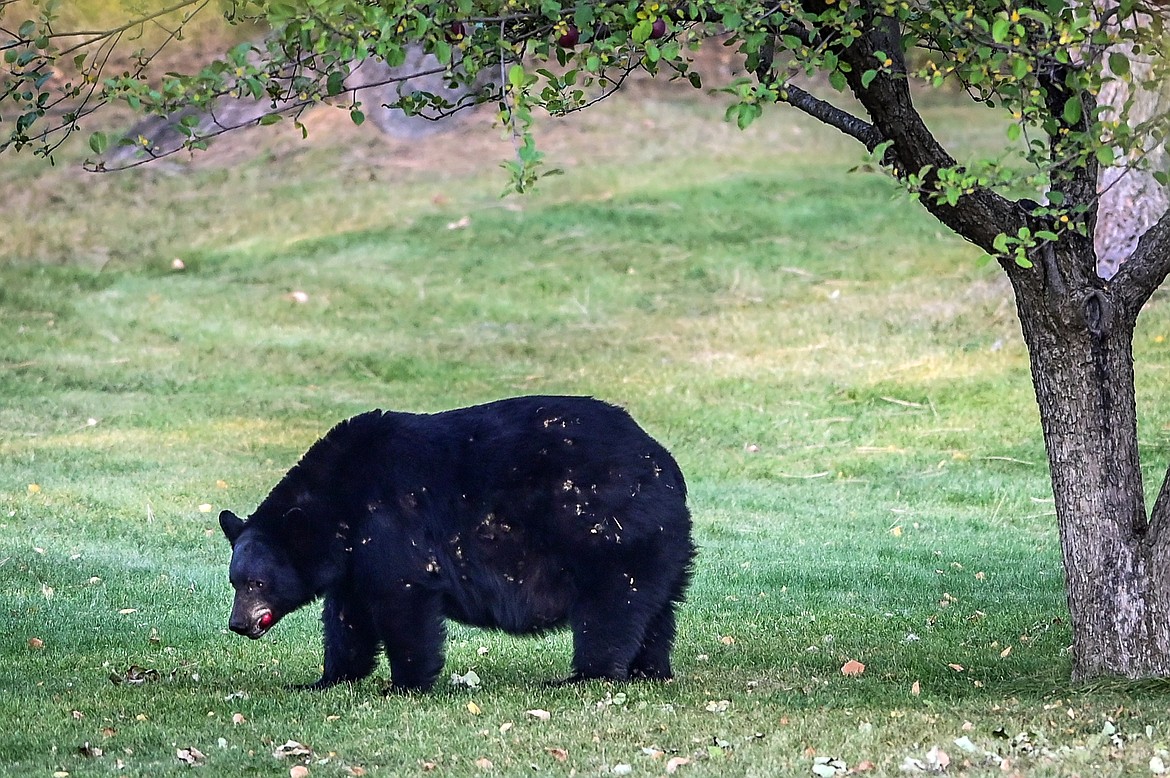Multiyear black bear study comes to Flathead Valley
KATE HESTON | Hagadone News Network | UPDATED 1 year, 4 months AGO
Kate Heston covers politics and natural resources for the Daily Inter Lake. She is a graduate of the University of Iowa's journalism program, previously worked as photo editor at the Daily Iowan and was a News21 fellow in Phoenix. She can be reached at [email protected] or 406-758-4459. | August 6, 2024 12:00 AM
State biologists are shining a light on Northwest Montana’s black bears as part of a multiyear effort to improve their understanding of the species’ habitat and population size.
In May, Montana Fish, Wildlife and Parks researchers began the second season of the black bear study, using a combination of barbed wire hair corrals west of Kalispell and location tracking collars. Experts plan to use the findings to better inform wildlife management practices — the last time the state surveyed the black bear population was in 2011.
“When we think back, 100 years, to like the very beginning of wildlife science ... the age-old question is how many animals do we have? It's been one of the most important questions. But in some ways, it's been one of the hardest questions to answer,” said Colby Anton, a black bear monitoring biologist at Montana Fish, Wildlife and Parks.
Data helps inform practices, he said. And the information collected could lead to adjusting harvest quotas.
“We’re very excited about it ... the more accurate we can be in estimating our populations, the more [Montana Fish, Wildlife and Parks] can do in setting the appropriate quotas and getting a balance between predators and prey,” said Pat Tabor, vice chair of the state Fish and Wildlife Commission.
Ungulate counts have decreased over the last quarter century, he said. The assumption is that the decline is linked to predators.
It’s not any single predator, Tabor said, but a contribution of factors, including habitat and climate changes. Black bears do play a big role in early spring ungulate killings, he said.
“There’s always been an abundance of [black bears]. I also think it’s been a strong held perception of most folks that the state has been ultra, ultra conservative in estimating their populations,” Tabor said.
The new study, once completed, will confirm or deny that perception. Up until this project, the state of Montana has been functioning off population estimates from 2011, published by biologists Richard Mace and Tonya Chilton-Radandt. They estimated the mean population at 13,307 black bears statewide.
Black bear harvest numbers have increased in recent years, which was one of the main drivers for initiating the project, according to Anton. The state wildlife agency hopes to understand the connection between black bear harvest and population change over time, he said.
In 2022, counting both spring and fall hunts, a total of 2,159 bears were harvested with 749 coming from Region 1, according to Montana Fish, Wildlife and Parks. In 2021, the state saw 1,598 bears harvested with 504 taken in Region 1. In 2020, the state total was 1,457 bears. Of those, 562 came from Region 1.
"THIS STUDY is very critical,” said Will Israel, the director of the Montana Outfitters and Guides Association. “Our No. 1 focus with our association, and by proxy our outfitters, is the health of the resource.”
Harvest quotas affect an ecosystem, he said. If too many bears are killed, that could negatively affect other species. If the quota is too low, bears could kill more ungulates and conflicts could increase with humans.
“Well, I think [hunting] controls the population, as does hunting with every species,” said Barbara Burns, an outfitter who formerly owned the Bob Marshall Wilderness Ranch with her husband. “But hopefully it is a well thought out, well planned and well-managed endeavor.”
Maintaining the population is important, she said, but so is doing it carefully.
The 2011 study found that Region 1 features the most black bear habitat in the state, including dense forests, riparian areas and open slopes. Over 40% of bears harvested in a year come from Region 1.
“The thing with science, though, is that we often have updated methods that we can implement. Both from the field sampling and the analytical side of things,” Anton said. “The value that we see in some of these revisits for sampling is to better understand what is going on with the trend of the population but also to double check ourselves.”
Agency officials, biologists and outfitters are looking forward to the results of the study — and seeing how they change the way the state does things.
Currently, Montana allows up to 37% of black bears harvested in the spring to be a sow, a number that could change if the estimated population varies substantially from the findings released in 2011.
“I'd just like to see if that is the effective percentage rate, and honestly I would like to know where the population is at overall compared to 10 years ago,” Israel said.
THE STUDY is looking at five distinct black bear sampling regions dispersed throughout the state. Each year, researchers study the population of bears in one of those ecoregions. Once they have sampled each region once, they will start the process over again.
Last year, the study focused on the western ecoregion. Next year, research will be in the central ecoregion, sampling bears in the Little Belt Mountain Range.
The current monitoring program, according to the state wildlife agency, will help officials gain an accurate understanding of the black bear population while accounting for regional differences. The results will also give officials a better understanding of how hunter harvest, and habitat quality and availability affect the overall population.
“We really want to try to get to a point where we have better understanding of where the population is at moment, but also a better understanding of where the population is going,” Anton said.
That then should aid the state in managing the animal to ensure that the population remains stable.
The hair corral sites are placed west of Kalispell, surrounded by bright orange warning signs. Members of the public are advised to stay out of those areas, including trapping locations for GPS collars, due to increased safety risks such as an increased presence of both barbs and bears.
“The message that we’ve put out here for black bear monitoring, they give us the ability to adapt to changes overtime. The estimates that we put out, the management, those things are not set in stone, and I don't think that is something we would ever want set in stone,” Anton said.
Reporter Kate Heston can be reached at [email protected] or 758-4459.
ARTICLES BY KATE HESTON

Veteran-owned mobile boat repair service anchors down in the Flathead Valley
The Kramers launched Flathead Mobile Marine to use their skills — they have decades of experience performing routine maintenance checks on a variety of boats as well as working with engines and electrical systems — and help boaters in the community.

With ski season near, resort reaches deal with staff
After 18 months of negotiations, Whitefish Mountain Resort executives and the resort’s ski patrol union are finalizing a one-year contract for the upcoming season.

Trapped in a car wreck, Woods Bay woman credits teens with saving her life
Driving home from a quilting event in Bigfork in September of last year, Carol Martin remembered that the sky was clear, the sun was shining, and she had a headache.

